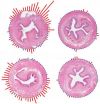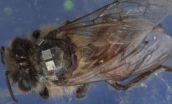(Press-News.org) SALT LAKE CITY Sept. 6, 2012 - University of Utah engineers mapped white blood cells called eonsinophils and showed an existing diagnostic method may overlook an elusive digestive disorder that causes swelling in the esophagus and painful swallowing.
By pinpointing the location and density of eosinophils, which regulate allergy mechanisms in the immune system, these researchers suggest the disease eosinophilic esophagitis, or EoE, may be under- or misdiagnosed in patients using the current method, which is to take tissue samples (biopsies) with an endoscope.
These findings are published as the cover article in the September 2012 issue of the Journal of Allergy and Clinical Immunology. Despite the limitations of current detection methods for EoE, the study authors say biopsies remain the current standard of care, but the engineers are working toward new diagnostic methods that could be available in five years.
In EoE, eosinophils typically found in the bloodstream invade the esophagus and start chewing away at its lining. Often triggered by food allergies, EoE symptoms overlap with other disorders such as acid reflux.
"The gold standard for understanding this disease is detecting the location and presence of eosinophils in the esophagus. Unfortunately, eosinophils are not uniformly distributed within the esophagus, which can lead to underdiagnosis," says study co-author Leonard Pease, assistant professor of chemical engineering at the University of Utah. He is also an adjunct professor of gastroenterology and pharmaceutics.
The University of Utah team showed that even a patient with known EoE would require more than 31 random tissue samples, or biopsies, from an area in the esophagus with low eosinophil density to reliably diagnose EoE. Currently, if a patient is suspected of having EoE, five to 12 biopsies are collected along the esophagus using an endoscope. If more than 15 eosinophils turn up in any one of these samples, a diagnosis of EoE is made.
"This is the first quantitative assessment of how eosinophils are distributed in the esophagus," says co-author Gerald Gleich, professor of dermatology at the University of Utah and specialist in eosinophil-related diseases. "Until now, someone would go in and snip around, but they wouldn't have this map to quantify the degree of infiltration of this disease in relationship to the actual anatomy. These findings impact how many biopsies a doctor should perform."
Since eonsinophils are scattered within the esophagus, EoE can go undetected until severe symptoms surface, ranging from painful swallowing to chest pains that mimic a heart attack.
"This is not the ideal way to diagnose EoE," says Pease. "If the distribution of eosinophils was 100 percent uniform, it wouldn't matter where you sample, but in fact it's patchy. Our mapping shows if you sample in one region, no diagnosis would be made, but if you took another region about an inch away, the same patient would appear to be severely diseased."
To generate a map of eosinophil distribution in the esophagus, lead author Hedieh Saffari examined each of 17 tissue sections taken at intervals every one-eighth to one-fifth of an inch along the esophagus of a known adult EoE patient. A typical adult esophagus is 10 inches long.
"For every cross section, I used microscopy to count the number of eosinophil cells along the entire perimeter of the tissue surface in each high-power field of view image," said Saffari, a chemical engineering graduate student. "There were somewhere between 40 and 120 of these images per cross section so it took a lot of time, but it was worth it to extract the information we were looking for. No one has done this type of mapping before."
Saffari's diligence paid off. With her painstakingly collected data, she and Pease used a statistical simulation technique to determine whether randomly sampling tissue would result in a positive diagnosis of EoE based on eonsinophil density.
"Our analysis shows that with current diagnostic conventions, you are only going to catch the patients with medium-to-high eonsinophil densities, which means we may be misdiagnosing patients as much as one out of every five times," says Pease. "Given this data, clearly endoscopy is not sufficient for a disease this patchy."
Gleich says their findings will inform future revisions of EoE diagnosis guidelines, but biopsies are "currently the standard of care and will not change in the near future."
Building on this study, Pease and Saffari are investigating technologies for labeling and detecting proteins shed by eosinophils in the esophagus, which would help detect EoE at an earlier stage. They have also filed a patent to use radiolabeled antibodies to map eosinophils throughout the entire esophagus, a new technique that would be evaluated with a clinical trial. "We're optimistic that such a diagnostic tool could be available in the next five years," Pease says.
Saffari adds this is part of the team's long-term goal to develop new strategies to enhance EoE diagnosis and understand what causes the disease.
Pease, Gleich and Saffari conducted the study with gastroenterologists Kathryn Peterson and John Fang and pathologist Carolin Teman at the University of Utah. This study was funded by the University of Utah, the Utah Governor's Office of Economic Development and the National Science Foundation.
INFORMATION:
University of Utah College of Engineering
72 S. Central Campus Dr., Room 1650 WEB, Salt Lake City, UT 84112
(801) 581-6911 fax: (801) 581-8692
www.coe.utah.edu
Biopsies may overlook esophagus disease
Study reveals limitations in detecting allergic disorder
2012-09-07
ELSE PRESS RELEASES FROM THIS DATE:
SF State biologists tag 'zombees' to track their flight
2012-09-07
SAN FRANCISCO, Sept. 6, 2012 -- After last year's accidental discovery of "zombie"-like bees infected with a fly parasite, SF State researchers are conducting an elaborate experiment to learn more about the plight of the honey bees.
The scientists are tagging infected bees with tiny radio trackers, and monitoring the bees' movements in and out of a specially designed hive on top of the Hensill Hall biology building on campus. At the same time, they are monitoring hives on campus and on the roof of the San Francisco Chronicle's offices for further signs of the mysterious ...
Well-known protein reveals new tricks
2012-09-07
A protein called "clathrin," which is found in every human cell and plays a critical role in transporting materials within them, also plays a key role in cell division, according to new research at the University of California, San Francisco.
The discovery, featured on the cover of the Journal of Cell Biology in August, sheds light on the process of cell division and provides a new angle for understanding cancer. Without clathrin, cells divide erratically and unevenly—a phenomenon that is one of the hallmarks of the disease.
"Clathrin is doing more than we thought ...
Even the very elderly and frail can benefit from exercise
2012-09-07
A study carried out by Dr. Louis Bherer, PhD (Psychology), Laboratory Director and Researcher at the Institut universitaire de gériatrie de Montréal (IUGM), an institution affiliated with Université de Montréal, has shown that all seniors, even those considered frail, can enjoy the benefits of exercise in terms of their physical and cognitive faculties and quality of life and that these benefits appear after only three months.
This discovery is excellent news, as increased life expectancy has also increased the number of frail seniors in our communities. In geriatrics, ...
OSA increases cardiovascular mortality in the elderly
2012-09-07
Untreated severe obstructive sleep apnea (OSA) is associated with an increased risk of cardiovascular mortality in the elderly, and adequate treatment with continuous positive airway pressure (CPAP) may significantly reduce this risk, according to a new study from researchers in Spain.
"Although the link between OSA and cardiovascular mortality is well established in younger patients, evidence on this relationship in the elderly has been conflicting," said lead author Miguel Ángel Martínez-García, MD, of La Fe University and Polytechnic Hospital in Valencia, Spain. "In ...
Prenatal diagnosis of congenital heart disease increases maternal stress, depression, and anxiety
2012-09-07
Cincinnati, OH, September 7, 2012 – Heart defects are the most common form of congenital malformations affecting newborns. Infants who were prenatally diagnosed with congenital heart disease (CHD) are more stable and have better outcomes than infants who were diagnosed after birth. Diagnosing CHD in a fetus also allows mothers to educate themselves on heart malformations, consider their options, and potentially plan for intervention or surgery after birth. However, a new study scheduled for publication in The Journal of Pediatrics finds that, along with these benefits, ...
Moffitt Cancer Center researchers study childhood melanoma characteristics
2012-09-07
Melanoma, newly diagnosed in more than 76,000 Americans in 2011, is the most common and dangerous form of skin cancer. Melanoma is rare in children, accounting for 1 to 4 percent of all melanoma cases and just 3 percent of pediatric cancers. Just as adult cases of melanoma are increasing, pediatric melanoma is rising at the rate of 1 to 4 percent per year.
The physicians and staff at Moffitt Cancer Center have a special interest in melanoma and related conditions occurring in childhood, and recently published results of their experience with cases of pathologically ...
Jungle Jumps Offers Tips for Maintaining Inflatables
2012-09-07
Inflatables are a significant investment, both financially and for the livelihood of your business, and should be cared for as such. A few simple care and maintenance steps will keep your inflatables in tip-top form and damage free.
To prevent your inflatable from becoming a host for bacteria and germs you must clean and sanitize it thoroughly after each use. After an event, while the inflatable is still inflated, do a walk through removing any loose debris and trash. Once this has been picked up, sweep out the unit, the pillars and the netting.
After all of the ...
Aug 8, 2012 Sonoma Energy Capital LLC. Drills Maunie #2 Well to Total Depth in N Maunie Field
2012-09-07
Sonoma Energy Capital, LLC. has successfully drilled the Maunie #2 Well to total depth in the N Maunie Field. The N Maunie field is a proven structure that has produced over 5 million barrels of oil from the formations above 3000 feet. " The Illinois basin is experiencing a modern oil boom and it is attracting oil producers from around the country ," according to Bob Nelson, President of Sonoma Energy Capital, LLC. "We are on the cutting edge of deep drilling in the Illinois Basin with our expert team". Sonoma Energy Capitals president, Bob Nelson, has ...
K2M Launches SERENGETI Complex Spine Minimally Invasive Retractor System at Scoliosis Research Society 47th Annual Meeting
2012-09-07
K2M, Inc., the largest privately held spinal device company in the world focused on developing innovative solutions for the treatment of complex spinal pathologies and minimally invasive procedures, today announced the launch of the SERENGETI Complex Spine Minimally Invasive Retractor System at the Scoliosis Research Society (SRS) 47th Annual Meeting in Chicago. SERENGETI Complex Spine brings K2M's focus on complex spine and minimally invasive together into one system by providing surgeons the ability to address deformity, trauma, and tumor, while promoting tissue preservation. ...
Benefit Auctions Auctioneer Cole Wyatt Davis Comes Out of Retirement.
2012-09-07
Benefit Auctions Auctioneer Col. Cole Wyatt Davis comes out of retirement. Cole had received so many letters, emails and phone calls from so many benefit and charities. Cole Wyatt Davis has worked for Non-profits all over the globe to help raise millions of dollars for great causes. Joan Cook said, " Cole is one of the greatest auctioneers of all time. He makes a benefit or charity gala / event fun, exciting and action packed when he is behind that microphone. Cole is not the normal charity or benefit auctioneer at all. He connects with the audience very fast and inner ...
LAST 30 PRESS RELEASES:
The key to lowering your water bill may already be at your door
Saliva testing may reveal early signs of diabetes and obesity
4D images show heat shield damage goes below the surface
Hibernator “superpowers” may lie hidden in human DNA
Changes in diet drove physical evolution in early humans
Experts call for science- and evidence-based AI policy
Challenges in governing rapidly emerging marine-climate interventions
Slowdown in protein translation drives aging in the killifish brain
Behavior drives morphological change during primate evolution
Climate interventions to save our oceans need stronger governance, experts warn
Do you want to freeze a cloud? Desert dust might help
Nanodevice uses sound to sculpt light, paving the way for better displays and imaging
Twinkle, twinkle leopard seal: songs below the ice flow like nursery rhymes
Potato evolved from tomato 9 million years ago
MIT researchers show how the brain distinguishes 'things' from 'stuff'
Impact of the MISSION act on quality and outcomes of major cardiovascular procedures among veterans
Not all low-grade prostate cancers are low risk
GLP-1 RAs and risk of nonarteritic anterior ischemic optic neuropathy in older patients with diabetes
The clinical practice guideline update on adult sinusitis emphasizes patient education, shared decision-making, and evidence-based treatment options
Big data begins to crack the cold case of endometriosis
This artificial sweetener could make cancer treatment less effective
Light-based listening: Researchers develop a low-cost visual microphone
Immunoglobulin replacement therapy shows no reduction in serious infections for patients with CLL
University of Colorado Anschutz Medical Campus awarded one of the largest clinical trial grants in campus history to lead trauma study
Weather-tracking advances are revealing astonishing extremes of lightning
Grasses are spendthrifts, forests are budgeters, in a nuanced account of plant water use
"Scrumping" windfallen fruits and the origin of feasting
How ‘scrumping’ apes may have given us a taste for alcohol
Scrumped fruit key to chimpanzee life and a major force of human evolution
Scientists discover new quantum state at the intersection of exotic materials
[Press-News.org] Biopsies may overlook esophagus diseaseStudy reveals limitations in detecting allergic disorder


